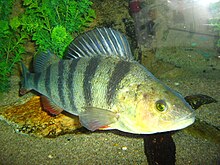| European perch | |
|---|---|
 | |
 | |
| Conservation status | |
 Least Concern (IUCN 3.1) | |
| Scientific classification | |
| Kingdom: | Animalia |
| Phylum: | Chordata |
| Class: | Actinopterygii |
| Order: | Perciformes |
| Family: | Percidae |
| Genus: | Perca |
| Species: | P. fluviatilis |
| Binomial name | |
| Perca
fluviatilis Linnaeus, 1758 | |
 | |
Perca
fluviatilis, commonly known as the European perch, is a predatory
species of perch
found in Europe
and Asia. In some
areas it is known as the redfin perch or English perch, and it is
often known simply as perch. The species is a popular quarry for anglers and has been
widely introduced beyond its native area, into Australia, New
Zealand, and South Africa. They have
caused substantial damage to native fish populations in Australia.
European perch are greenish with red pelvic, anal and caudal fins. They have five to nine dark vertical bars on their sides.
European perch can vary greatly in size between bodies of water. Perch can live for up to 22 years, and older perch are often much larger than average; the maximum recorded length is 60 cm (24 in). The British record is 2.8 kg (6 lb 2 oz), but they grow larger in mainland Europe than in Britain, and to as much as 9 kilograms (20 lb) in Australia.[1][full citation needed] As at Nov 2010 the official all tackle world record stands at 1.5 kg (3 lb 5 oz)[clarification needed] although individual records from various areas record larger fish.[2][3]
The perch spawns (in the Northern Hemisphere) at the end of April or beginning of May, depositing the eggs upon water plants, or the branches of trees or shrubs that have become immersed in the water; it does not come into condition again until July. The eggs have been known to stick to the legs of wading birds and then transferred to other waters that the birds visit.[citation needed]
European perch are greenish with red pelvic, anal and caudal fins. They have five to nine dark vertical bars on their sides.
European perch can vary greatly in size between bodies of water. Perch can live for up to 22 years, and older perch are often much larger than average; the maximum recorded length is 60 cm (24 in). The British record is 2.8 kg (6 lb 2 oz), but they grow larger in mainland Europe than in Britain, and to as much as 9 kilograms (20 lb) in Australia.[1][full citation needed] As at Nov 2010 the official all tackle world record stands at 1.5 kg (3 lb 5 oz)[clarification needed] although individual records from various areas record larger fish.[2][3]
The perch spawns (in the Northern Hemisphere) at the end of April or beginning of May, depositing the eggs upon water plants, or the branches of trees or shrubs that have become immersed in the water; it does not come into condition again until July. The eggs have been known to stick to the legs of wading birds and then transferred to other waters that the birds visit.[citation needed]
Taxonomy
The first
scientific description of the river perch was made by Peter
Artedi in 1730. He defined the basic morphological signs of this species
after studying perch from Swedish lakes. Artedi described its features, counting
the fin rays scales and vertebrae of the typical perch.
In 1758 Carl Linnaeus named it Perca fluviatilis.[4] His description was based on Artedi's research.
In 1758 Carl Linnaeus named it Perca fluviatilis.[4] His description was based on Artedi's research.
Fishing
Baits for perch
include minnows, or brandling, red, marsh, and lob worms, shrimps and artificial
lures. The tackle needed is fine but strong. Artificial lures are also
effective, particularly for medium-sized perch.
Aquarium care
Keeping
of perch requires a large tank and a suitable diet. The tank needs to be thickly
planted with plants such as Elodea, Egeria and others.
Perch can be kept in ponds with other appropriate fish; as with most fish,
larger ones may consume fry if they are available. A suitable diet is earthworm, flakes, silversides and frozen
foods such as blackworm. If fed
properly Perch tend to phase away from small fish.[clarification
needed]
Relation to the yellow perch
Because of their similar appearance and ability to
cross-breed, the yellow perch (Perca
flavescens) has sometimes been classified as a subspecies of the European
perch, in which case its trinomial name
would be Perca fluviatilis flavescens.
White
perch
- Article Source: http://en.wikipedia.org/
More Stories: Gofishtalk

No comments:
Post a Comment